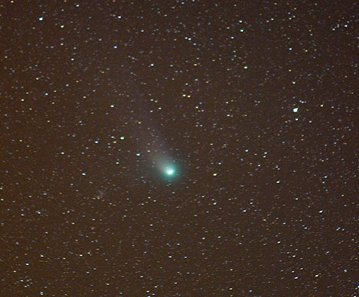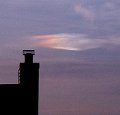 Would you like a call when auroras appear over your home town? Sign up for Spaceweather PHONE.
Would you like a call when auroras appear over your home town? Sign up for Spaceweather PHONE.
AURORA WATCH: Earth is exiting a solar wind stream flowing from a coronal hole on the sun. The chances for a geomagnetic storm or auroras today are subsiding. [gallery]
COMET NEAT: Comet NEAT (C/2001 Q4) is receding from Earth after its 30 million mile close approach on May 7th. Even so, it is still relatively bright, shining like a 3rd magnitude star; the comet remains an easy target for binoculars or the unaided eye from dark-sky locations. Look for it after sunset in the southwestern sky; on May 9th it will be close to the bright star Procyon. [sky maps: May 8, May 9, May 10] [ephemeris]

Above: Comet NEAT on May 7, 2004, photographed by Bob Sandy and Carmen Lang from the Blue Ridge Parkway near Roanoke, VA.
more images: from Rob Ratkowski of Pukalani, Maui (15s exposure, May 7); from Babak A. Tafreshi at Dizin peak, north of Tehran, Iran (May 7); from Rémi Boucher at Mont-Mégantic, Quebec, Canada (33s exp., May 7); from Rick Schrantz of Lexington, Kentucky (7.5 min. exp., May 7); a sketch from Ray Pickard of the Bathurst Observatory in NSW Australia (May 7); from Les Marczi near Welland Ontario, Canada (May 7); from Federico Hemmerich of the Canary Islands, Spain (May 7); from Tom Simmons of Tucson, Arizona (1s exp., May 7).
 RAINBOW SMOKESTACK: The sun was rising over Mason, Ohio, on April 29th when Jun Lao spotted a bright morning sundog (pictured right). "It was situated close to the chimney of a neighbor's house, so that it seemed like colored smoke," says Lao.
RAINBOW SMOKESTACK: The sun was rising over Mason, Ohio, on April 29th when Jun Lao spotted a bright morning sundog (pictured right). "It was situated close to the chimney of a neighbor's house, so that it seemed like colored smoke," says Lao.
Rainbow-colored sundogs like these are caused by airborne ice crystals. Look for them anytime the sun is out and the sky is laced with wispy clouds. Even during hot spring and summer, such clouds are cold enough to freeze water into sunlight-bending crystals.
LUNAR ECLIPSE: Millions of people in Europe, Asia, Africa, Australia and South America watched the Moon turn sunset-red on May 4th when it glided through Earth's shadow--a.k.a. a total lunar eclipse. Visit our gallery to view photos of the eclipse from around the world.

